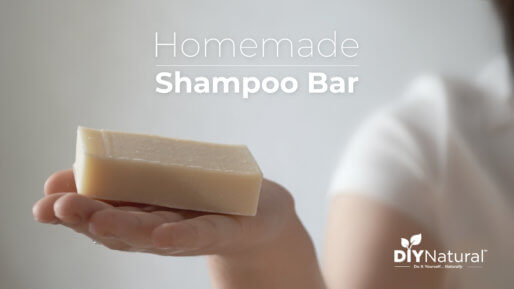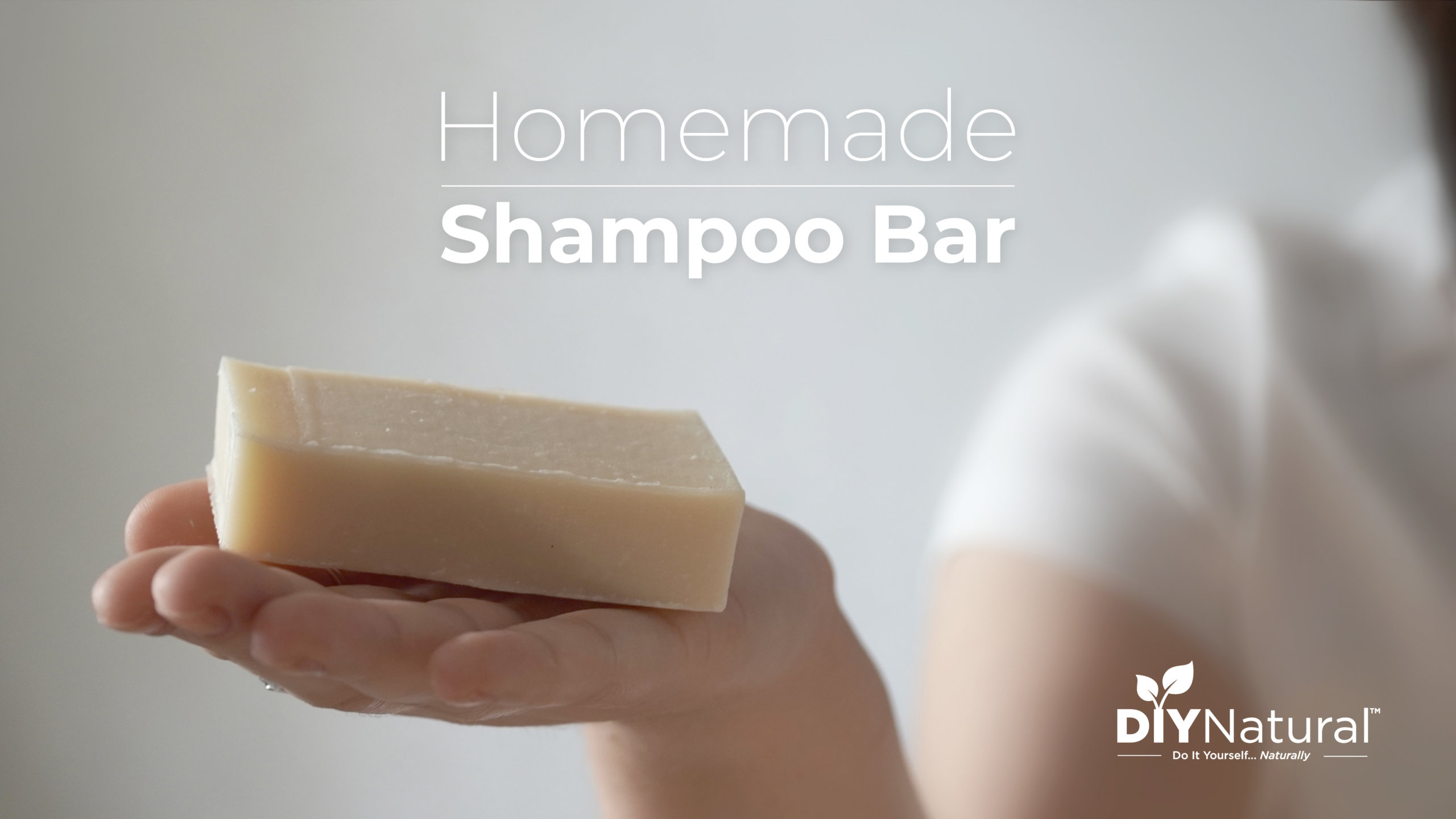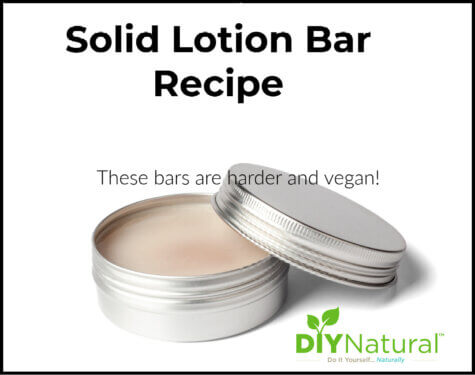
I receive many requests for a DIY shampoo bar so I’m sharing my recipe! This simple homemade shampoo bar will leave your hair soft and shiny.
I’m a soap maker, so people ask me to make all kinds of soap. Lately, I’ve been getting requests for a solid homemade shampoo bar. I have a great recipe that will leave your hair soft and shiny.
Why Use a Solid DIY Shampoo Bar?
There are many reasons someone might want a solid bar as opposed to liquid shampoo or this other liquid homemade shampoo.
Solid homemade shampoo bars are great for traveling because you don’t have to worry about them spilling into a bag. These bars can also help you save money and take up less space in the shower. Some people like a solid bar for easier handling; shampoo bottles can get slippery and can be heavy for people with weakness in their hands. Furthermore, I love them because I can add exactly what I want to the bar and leave out anything I don’t want. They’re gentle on hair and perfectly customizable!
Basic Soap Making
If you haven’t made soap before, or read my article on basic soap making, you’ll want to familiarize yourself by reading this first: Homemade All Natural Soap. We simplified the process by converting this recipe from weights to measurements. We tested and perfected the measurements.
This method has been used with much success and can be doubled or tripled easily. The oils are the ingredients that change the most with a homemade shampoo bar.
Choosing Oils for Hair
There are some great oils for adding softness and luster to hair. These oils are suitable for all hair types (even colored hair):
- Sweet Almond Oil
- Avocado Oil
- Macadamia Nut Oil
- Castor Oil*
- Palm Oil (see this article on sustainable palm oil)
- Wheat Germ Oil
- Grapeseed Oil
- Rice Bran Oil
You can find most of these oils in your local supermarket, or online here.
Considerations When Choosing Oils
There are many other oils you can choose for this homemade shampoo bar, but you’ll want to stay very close to the same SAP value as the olive and coconut oils. Consult an SAP chart to be sure the oil you use is within the same range.
*Castor oil is excellent for hair but is a bit low on the scale. If you decide to use it, you’ll want to decrease the amount of lye by about a teaspoon. This will even out the proportion, otherwise you would end up with a hard crumbly bar due to excess lye.

Homemade DIY Shampoo Bar (Cold Process)
I receive many requests for a DIY shampoo bar so I'm sharing my recipe! This simple homemade shampoo bar will leave your hair soft and shiny.
- Prep Time
- 20 minutes
- Active Time
- 1 hour
- Curing Time
- 28 days
- Total Time
- 28 days 1 hour 20 minutes
- Servings
- 6 bars
- Estimated Cost
- $5
Equipment
Ingredients
- ⅔ cup olive oil
- ⅔ cup coconut oil
- ¾ cup cool distilled water
- ⅔ cup other oil (see list above)
- ¼ cup lye (sodium hydroxide)
- 2 Tbsp essential oils
Instructions
-
Have everything laid out and ready to go before beginning this project. You’ll need to be prepared to move quickly for some of the steps.
-
Cover your work area with a newspaper, put on your gloves and goggles, and mix the olive, coconut, and "other" oils in a large glass or stainless steel bowl. If any are solid, melt them prior to measuring.
-
Measure water into a glass or stainless steel container. (Be sure to use a heatproof container when mixing, as the exothermic reaction when lye is added can cause heat around 200°F.) Measure your lye, making sure you have an exact ¼ cup. Have a spoon ready. Stirring as you pour, slowly pour the lye into the water, NEVER the other way around. Continue stirring until the mixture begins turning clear. Stand back while you stir to avoid the fumes. Allow the lye/water mixture to cool to about 125°F.
-
When the oil mixture is at 75°F and your lye/water mixture is around 125°F, slowly pour the lye into the oils and stir. For the next 5 minutes, stir by hand. This will allow as many of the oil molecules to come in contact with as much of the lye as possible. After 5 minutes, use a stick blender (like this) to mix, being careful not to introduce air. Blend until the mixture is thick like vanilla pudding; this is called "trace." (Watch this video to see what trace looks like.)
-
When you have achieved trace, you can add an addidional tablespoon of your "other oil". This could be grapeseed, castor oil, or any of the other oils listed in the oil section above. This extra oil will add extra moisture to your homemade shampoo bar and the oil will not be used by the lye, thus allowing it to add extra conditioning for your hair. You can also add optional essential oils at this point. Stir thoroughly to combine.
-
Pour the soap mixture into molds and cover with plastic wrap. (These silicone molds are the perfect shape.) After 24 hours, turn it out onto a piece of parchment paper or baking rack. Leave in a dry place and turn once a week or so (which is not necessary if using a baking rack). Your homemade shampoo bars can be used after curing for 4 weeks. The bars will be milder the longer they are allowed to cure. A month-long wait is well worth the end product!
Recipe Video
Notes
To familiarize yourself with soapmaking, read this how-to make soap article. Wear protective gloves and goggles and cover all work surfaces. Use caution when mixing the lye and water as the fumes can cause a choking sensation in your throat. This will diminish after a minute or so.
- Remember to be very careful using lye. It can cause burns if not handled correctly. Keep some white vinegar handy in case of spills.
- For this soap, I wouldn’t add dried herbs. They can get stuck in your hair and be difficult to remove.
- This soap can also be made in a large mold. Cut it into bars after the first 24 hours when you remove it from the mold. They will be too hard to cut if you wait too long.
- Using one of the conditioning rinses listed above will help restore hair to a healthy pH level, add shine, and prevent buildup.
- Love the idea of natural hair care, but don’t want to make your own? Here is a line of hair care products DIY Natural has tested and LOVES.
Made this recipe?
Mention @diynatural or tag it #diynatural!
Using Your Homemade Shampoo Bar
Thoroughly wet hair. Rub shampoo bar from scalp to ends, covering each section of hair, OR rub between hands to create a nice, foamy lather. Work shampoo into your hair, gently massaging the scalp and working through to ends. Rinse thoroughly and follow with your normal conditioner or one of the following rinses:
Have you ever created a homemade DIY shampoo bar? Let us know about your experience!
*******




Could you use a conditioning agent to your recipe like BTMS-25? and if yes how much and when would you add it?
Hi Rik. We have not tried it, but if you do I would add it in step 5. If you try it let us know how it works. Blessings.
“Keep your love of nature, for that is the true way to understand art more and more.” ~Vincent Van Gogh
Can you add juice to the soap in some way?
Hi Debra – I love your soap recipe and am excited to try this one. I have noticed that the scent from essential oils in my soaps dissipates by the time the soap is cured and ready to use. I am very sad about this. Do you have any tips to contain the essential oil scent – from the time the soap is cured to when the product is finished?
Hello Natalie, I suggest using more essential oil if you can afford it!
What does Debra think? Maximum of 2% essential oil was suggested to me when I did a course with a pro many years ago.
I find that the finished soap component keeps for eons, but the essential oil scents do not.
The other alternative is to make smaller batches more frequently.
Sasha ?
Hi Debra, ive been doing some research on shampoo and I wanted to make it as organic as possible while still retaining a PH level of around 5/6. I have seen someone use soap nuts in a liquid shampoo, could these be used in this method, do you have any experience on using soap nuts in shampoo?
Also thanks for this recipe, really appreciated!
Thanks,
Louis.
If the ph is that low do you add preservatives.
Hello Louis, I’m not online much so this is a rather delayed comment. You might not read it!
I’ve been making organic cold process soap products for years. I do not market anything. It’s just for gifts and my own use. My interest started because I need to wash my hands a lot and found the endless list of chemicals in commercial soap quite scary.
I’m in ?? and I initially did a one day course here with a professional soapmaker.
I asked asked her about using organic oils. She said it was fine, but the mixture would take ages to reach trace. How right she was! I have to organise my whole day around it. However I only make about 3 batches/year so it’s not a problem.
The finished soap keeps for ages, but any essential oils in the soap lose their potency over time. I’ve not measured the pH. I never use preservatives.
I’m no chemist but the properties of organic oils are different to non organic in some way.
What is your own experience?
Or Debra’s?
I love trying the recipes out Debra ?
Sasha
Help!!
Hi I made this recipe but accidentally used washing soda instead of lye! Help!! How can i save it? Even if it just becomes normal shampoo? 1st time maker and silly mistake! lol
thanks for your time ?
Thank you!! Soap is the only product that doesn’t irriate my scalp like store bought shampoo. I want to make my own soap when Fall time hits.
Hi there. I tried your recipe but it’s ph was about 8, which is too high. Have you checked the pH yourself? What are your findings regarding pH of this recipe?
Hi! pH on any soap product ranges from 8-10, which is fine. If you try to lower the pH, it will no longer be soap as it changes everything. Don’t worry about the pH and you’ll be fine.
What is the PH lvl of a cured bar? I prefer a normal natural shampoo bar but I know with shampoo the normal ph is 7-9 depending on the recipe. Need to make a shampoo bar between 5-6.
If you make this bar exactly according to the recipe, Brittany, it will be about 6.5. The castor brings the pH down some. If you want a bar lower in pH, you can try using vinegar or lemon juice in the water or adding citric acid at the trace. I’ve never done this, I’ve only read about it, so you’ll need to do some research and experimenting.
How do I use homemade lye from wood ash instead of lye bead/flakes/or crystals? What are the measurements?
Please could you substitute cup measurements for all oz or all grams for all the shampoo bar ingredients as “cups” vary a lot in size? Would love to try this
Also is it possible to use a small % of beeswax in a soap recipe? I understand it has a very different sap value to most oils.
Thanks
:))
I have in another comment Sasha. It’s 4.75 ounces for the oils, 5.75 ounces for the water and 2.5 ounces for the lye. I’ve been using the measured amounts for years and have not had a problem since I started. You just need to make sure your oils are liquid, so melt and hard oils first, and make sure the lye is in bead form, not flakes. Many “professional” soap makers have said this will never work, but I’ve never had a problem.
Sorry, Sasha, I forgot your beeswax question. Beeswax doesn’t saponify, so adding it would not change the amount of oil you use. I add beeswax to get a harder bar or to avoid soda ash. For this recipe, a teaspoon or so is a good amount. You’ll need to melt it and add it to the oils before you add the lye to them. If you add it at the trace, you’ll get hard lumps of wax because the mix is cooler than the melted wax.
What % excess fat is in this recipe? I usually do 6-7% in my CP soap.
According to the lye calculator I use, 4.75 ounces by weight of each of the 3 oils (I picked avacado for the 3rd), 2.43 ounces of lye would yield a 0% excess fat bar, and using 2.5 ounces as suggested in your comment above would actually result in a lye-heavy bar. I’m sure I am making something in my calculations but don’t know what – any help would be apprecieated!
Hi Denise! Actually, the bar doesn’t end up lye heavy. The amount of lye is exactly what you need for the amount of oil. I never superfat or do a lye discount because I’ve never found it to be necessary, and my customers have been happy with my soap. I’ve found that superfatting leads to a shorter shelf life and early rancidity. Of course you can if you want to. In this size batch, a tablespoon to 1/4 cup of extra oil is enough. Or you can take a lye discount of one tablespoon. That will give you enough extra oil for superfatting.
Hello, I made these, however the shampoo bar isn’t hardening at any speed, it has been almost two weeks and they are still maliable and soft. Any ideas why? I used almond oil and sandalwood essence . Thanks!
Madelaine – I used Sweet Almond Oil for my 3rd ‘Other Oil’ also, maybe its too soft because I made mine Fri night & its still super soft. I’m going to give it several days because they cant be un-molded as is. Debra help!
Hello! My family camps a lot and we generally use biodegradable soap (ie Dr Bronners) to bathe in the lakes. Would this shampoo bar biodegrade?
It is, Beth! All of my soaps are 100% biodebradable unless color, clay or pumice is used in them. Most colors are made from some type of rock, such as mica, and clay and pumice start out as rock as well.
Hi,
But soap has a pH of 9 to 12 and the higher pH is not really good for aquatic life. Biodegradability should not be the only consideration when choosing soap for camping. Having said that, your soap is still much better than commercial versions.
Hello! Love the recipe and instructions! Quick question, could you infuse one of the oils with herbs prior to making the shampoo?
You sure can, Amy! I use calendula infused oil all the time in my soap and shampoo bars.
Thank you for the recepie! I’ve been making soap for a while now but never shampoo bars.
I am interested in the weight measurements as well!
And another question: do you have any experience with shampoo bars in hard water? I’ve read that it might be problematic to use in hard water and that’s what kept me from making shampoo bars because I have super hard water at home…
Hi Juliane. I posted the weights in the question above for you and Marie and any others who might want it. As to your other question, yes, hard water can cause issues, not just for making them, but for using them too. For making them, always filter your water so that none of the minerals interfere with the actionof the lye. Lye will attack minerals first, so in hard water, there may not be enough lye left for your oils to turn to soap. Then, in using it, you may not get a lot of lather, again, due to the minerals in the hard water. A filter on your shower head may help, but it may not. You could add a small amount of liquid glycerin at the trace when you make the bar. A tablespoon may help to increase lather somewhat. But, all is not lost. Lather is only aesthetic. You don’t need lather for soap to work right. It’s just been there for so long that we think it needs to be.
Can you give exact weight measurements for this recipe please? I personally prefer to use weight rather than cup measurements.
Sure can Marie! I know a lot of people prefer to weigh the amounts. I’m actually working on an article right now on weights vs volume. For this recipe, the oils would all be 4.75 ounces, the water would be 5.75 ounces and the lye would be 2.5 ounces. I had to look for my recipe since i’ve made soap by volume for so long!
Can this recipe be made using the HP Method?
I’m pretty sure you can. Hp just speeds up the curing process.
Thanks again Jan! I’m pretty sure you can too, KaDesha. I’ve never tried it, but I’ve done so many other things with hot process, that it makes sense that it would work. Let me know if you try it!
Could you ground the herbs tova fine powder? Just curious, because I am going to try this and a few other recipes ( body wash and laundry detergent and dish detergent) once I’m settled in my new apartment.
You could, Danie, and it would help to rinse them out of your hair easier. I dry a bunch and then keep them in gallon glass jars until I’m ready to use them.
Can you create a shampoo soap bar without using lye and use an alternative instead ?
No you can’t. The lye is what turns it into soap.
Thanks for chiming in Jan! It is true that you can’t make soap without lye, Cat, but there is no lye left in the soap when it is done curing. This process takes between 2-6 weeks, depending on the recipe used. If you don’t want to handle lye at all, you can use a melt and pour base and add some castor oil (or another nourishing oil) and your essential oils to it. Be aware though, that added oil will cut down on the lather, although it will still work fine.
Can this be used to bathe too
I use my soap and shampoo bars interchangeably. They work fine!
Absolutely! These bars will be extra moisturizing for skin too!
I have made soap using your recipe similar to this one with excellent results. I can’t wait to try this! I think that my sunflower oil has found its purpose! Do the essential oils serve a purpose other than making the shampoo smell nice?
You can add essential oils that you know have benefits for hair (many of them do!), or you can just use your favorite ones for scent. Have fun making this new recipe!